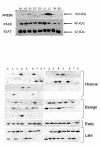E2F5 status significantly improves malignancy diagnosis of epithelial ovarian cancer
- PMID: 20181230
- PMCID: PMC2841139
- DOI: 10.1186/1471-2407-10-64
E2F5 status significantly improves malignancy diagnosis of epithelial ovarian cancer
Abstract
Background: Ovarian epithelial cancer (OEC) usually presents in the later stages of the disease. Factors, especially those associated with cell-cycle genes, affecting the genesis and tumour progression for ovarian cancer are largely unknown. We hypothesized that over-expressed transcription factors (TFs), as well as those that are driving the expression of the OEC over-expressed genes, could be the key for OEC genesis and potentially useful tissue and serum markers for malignancy associated with OEC.
Methods: Using a combination of computational (selection of candidate TF markers and malignancy prediction) and experimental approaches (tissue microarray and western blotting on patient samples) we identified and evaluated E2F5 transcription factor involved in cell proliferation, as a promising candidate regulatory target in early stage disease. Our hypothesis was supported by our tissue array experiments that showed E2F5 expression only in OEC samples but not in normal and benign tissues, and by significantly positively biased expression in serum samples done using western blotting studies.
Results: Analysis of clinical cases shows that of the E2F5 status is characteristic for a different population group than one covered by CA125, a conventional OEC biomarker. E2F5 used in different combinations with CA125 for distinguishing malignant cyst from benign cyst shows that the presence of CA125 or E2F5 increases sensitivity of OEC detection to 97.9% (an increase from 87.5% if only CA125 is used) and, more importantly, the presence of both CA125 and E2F5 increases specificity of OEC to 72.5% (an increase from 55% if only CA125 is used). This significantly improved accuracy suggests possibility of an improved diagnostics of OEC. Furthermore, detection of malignancy status in 86 cases (38 benign, 48 early and late OEC) shows that the use of E2F5 status in combination with other clinical characteristics allows for an improved detection of malignant cases with sensitivity, specificity, F-measure and accuracy of 97.92%, 97.37%, 97.92% and 97.67%, respectively.
Conclusions: Overall, our findings, in addition to opening a realistic possibility for improved OEC diagnosis, provide an indirect evidence that a cell-cycle regulatory protein E2F5 might play a significant role in OEC pathogenesis.
Figures



Similar articles
-
E2F5 Promotes the Malignancy of Ovarian Cancer Via the Regulation of Hippo and Wnt Pathways.Genet Test Mol Biomarkers. 2021 Mar;25(3):179-186. doi: 10.1089/gtmb.2020.0166. Genet Test Mol Biomarkers. 2021. PMID: 33734894
-
Tissue CA125 and HE4 Gene Expression Levels Offer Superior Accuracy in Discriminating Benign from Malignant Pelvic Masses.Asian Pac J Cancer Prev. 2016;17(1):323-33. doi: 10.7314/apjcp.2016.17.1.323. Asian Pac J Cancer Prev. 2016. PMID: 26838232
-
Vascular endothelial growth factor (VEGF) improves the sensitivity of CA125 for differentiation of epithelial ovarian cancers from ovarian cysts.Arch Gynecol Obstet. 2013 Oct;288(4):859-65. doi: 10.1007/s00404-013-2819-7. Epub 2013 Apr 7. Arch Gynecol Obstet. 2013. PMID: 23564055 Clinical Trial.
-
New tumor markers: CA125 and beyond.Int J Gynecol Cancer. 2005 Nov-Dec;15 Suppl 3:274-81. doi: 10.1111/j.1525-1438.2005.00441.x. Int J Gynecol Cancer. 2005. PMID: 16343244 Review.
-
Roles of CA125 in diagnosis, prediction, and oncogenesis of ovarian cancer.Biochim Biophys Acta Rev Cancer. 2021 Apr;1875(2):188503. doi: 10.1016/j.bbcan.2021.188503. Epub 2021 Jan 7. Biochim Biophys Acta Rev Cancer. 2021. PMID: 33421585 Review.
Cited by
-
Aberrant Promoter Methylation at CpG Cytosines Induce the Upregulation of the E2F5 Gene in Breast Cancer.J Breast Cancer. 2016 Jun;19(2):133-41. doi: 10.4048/jbc.2016.19.2.133. Epub 2016 Jun 24. J Breast Cancer. 2016. PMID: 27382388 Free PMC article.
-
Identification of Alternatively-Activated Pathways between Primary Breast Cancer and Liver Metastatic Cancer Using Microarray Data.Genes (Basel). 2019 Sep 25;10(10):753. doi: 10.3390/genes10100753. Genes (Basel). 2019. PMID: 31557971 Free PMC article.
-
TcoF-DB: dragon database for human transcription co-factors and transcription factor interacting proteins.Nucleic Acids Res. 2011 Jan;39(Database issue):D106-10. doi: 10.1093/nar/gkq945. Epub 2010 Oct 21. Nucleic Acids Res. 2011. PMID: 20965969 Free PMC article.
-
Identification of metabolites in the normal ovary and their transformation in primary and metastatic ovarian cancer.PLoS One. 2011;6(5):e19963. doi: 10.1371/journal.pone.0019963. Epub 2011 May 19. PLoS One. 2011. PMID: 21625518 Free PMC article.
-
E2F2/5/8 Serve as Potential Prognostic Biomarkers and Targets for Human Ovarian Cancer.Front Oncol. 2019 Mar 22;9:161. doi: 10.3389/fonc.2019.00161. eCollection 2019. Front Oncol. 2019. PMID: 30967995 Free PMC article.
References
-
- Bast RC Jr, Xu FJ, Yu YH, Barnhill S, Zhang Z, Mills GB. CA 125: the past and the future. Int J Biol Markers. 1998;13(4):179–187. - PubMed
Publication types
MeSH terms
Substances
LinkOut - more resources
Full Text Sources
Other Literature Sources
Medical
Research Materials
Miscellaneous

